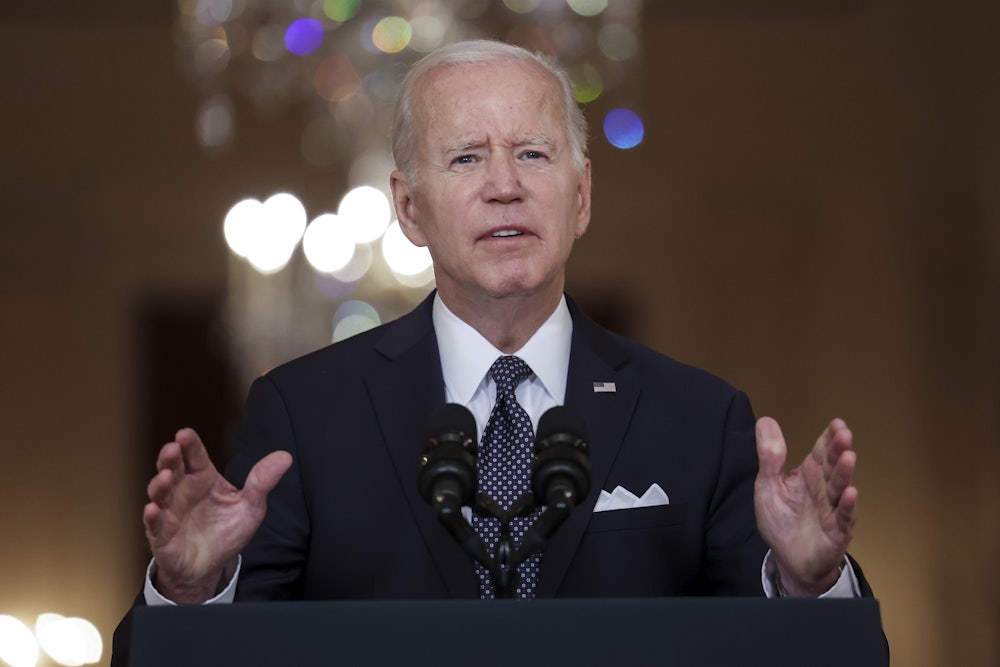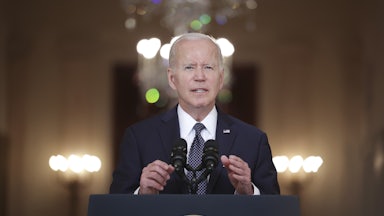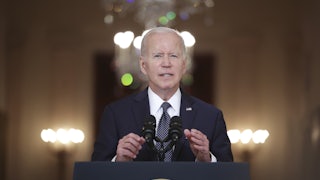Last week was Messaging Week in the Biden White House. With poll numbers stubbornly low, the Democratic agenda stalled in Congress, and little progress being made in the biggest year’s biggest crises—gun violence, inflation, the war in Ukraine—President Biden and his aides have decided to try to fix one thing they actually have some control over: how they talk about what the administration is actually doing. Naturally, NBC News dutifully reported on the president’s frustrations with his administration’s messaging—and his aides’ tendency immediately to “walk back” bold statements he has made, particularly on foreign policy. And so officials set out doing what administrations often do when they feel the need to aggressively correct the record: They tried to earn themselves some mainstream media attention.
Biden officials began holding bigger, flashier press conferences—including one with K-Pop superstars BTS. Joe Biden unleashed his inner David Brooks, writing not one but two op-eds: One, in The New York Times, focused on the administration’s Ukraine policy; a second, submitted to The Wall Street Journal, detailed the president’s efforts to fight inflation. The goal was clear: shift attention away from negative stories about intractable problems and instead initiate a larger conversation about the steps the White House was taking to confront those dilemmas. It didn’t work. In fact, it may have backfired.
One problem with bringing attention to your messaging problems by announcing an intention to force a “pivot” in the “narrative” is that it draws a bright line around dysfunction inside the administration. And so the media pivoted to one of their favorite narratives instead: The Democrats are in disarray—something tautologically proven by their fixation on the need to “change the message.” NBC’s headline read, “Inside a Biden White House adrift.” CNN noted that “Beneath Biden’s struggle to break through is a deeper dysfunction among White House aides.” The effort to change the message only ended up reinforcing the very story the White House wanted to change: Biden and the Democrats are in deep trouble.
This all stems from a stubborn misreading of the political media ecosystem. Part of the administration’s misalignment arises from the deep belief, held by a White House staffed by many old enough to collect social security, that bringing your story to old media—yes, even television news counts as old media—is sufficient to sway public opinion in 2022. More importantly, Democrats take it as an article of faith that if they simply put their substantive, policy-driven story out there—and get it positioned by mainstream reporters opposite the Republican Party’s firehose of lies and derangements—the mainstream media will recognize that Democrats are actually committed to fixing problems, unlike the GOP, and that from there reporters will do the rest. Once the ball is handed to the truth-telling guardians of the public trust, the message will take wing, and the public will absorb it, accept it, and act upon it by supporting the party of fundamental reasonableness.
In a perfect world, maybe this is enough. It doesn’t work in the one we’re stuck in—and the rash of stories highlighting internal dysfunction inside the White House is instructive: The press is never going to carry the party’s water for it. In fairness, it really shouldn’t! But this tidy plan isn’t working due to less charitable reasons than the media’s devotion to journalistic ethics. The Biden White House needs to understand this basic truth: Mainstream political outlets will always highlight division and dysfunction over policy. This is how stories about backroom infighting and The Drama at Court came to dominate the press instead of Biden’s plan to Whip Inflation Now. Anyone who has spent any amount of time watching cable television over the last 20 years understands that these outlets are absolute junkies for conflict and failure. It’s not clear that the administration has figured this out.
Perhaps this is too pessimistic. Biden’s Thursday night speech on gun control suggested that there lay another path forward, outside of the echo chamber. Here, Biden pitched more fiery rhetoric toward a different audience, laying blame for the epidemic of mass shootings where it belongs: with Republicans, who have stubbornly refused to compromise on gun control. Repeating the word “enough,” Biden angrily explained why nothing was getting done:
But, as we know, in order to get anything done in the Senate, we need a minimum of 10 Republican senators. I support the bipartisan efforts that include a small group of Democrats and Republican senators trying to find a way. But my God, the fact that the majority of the Senate Republicans don’t want any of these proposals even to be debated or come up for a vote, I find unconscionable.
It felt a little like a preemptive strike, given that there is little hope that this small group of senators is likely to produce anything that will appeal to 10 Republicans. (Indeed, Axios noted on Friday that the administration was “bearish” about the fate of the legislation being hammered out by this working group.) For 10 years, Republicans have occasionally feigned interest in compromise gun-control legislation, only to drop the effort as soon as media and public interest moves elsewhere; there’s no reason to believe that won’t happen again. Here, however, Biden demanded something this group is unlikely to press for—a return of the assault weapons ban—and made the case directly to the American people. The press has, by and large, followed him there, giving the speech far more coverage than any of the administration’s other milquetoast “messaging efforts.”
This also has the added advantage of revealing GOP radicalism. Nothing in Biden’s speech was particularly aggressive—assault weapons were banned between 1994 and 2004, and other policies like red flag laws and expanded background checks are popular. And yet Lindsey Graham nevertheless tweeted, “I stand ready to vote on ALL the proposals mentioned by President Biden tonight and encourage the Democratic Leader to bring them forward” after the speech—a sure sign the South Carolina senator was ready to vote down popular gun-control provisions.
There is an advantage of going on the offensive and laying your case out directly, rather than just handing an essay to The Wall Street Journal and hoping for the best: There’s no hemming and hawing from reporters who aren’t comfortable admitting to the base reality of American politics: that one party has fully radicalized and refuses to make simple, popular compromises in the name of public health and safety. No one should be under any illusion that Biden’s speech is going to get bipartisan legislation passed. But it may just change the narrative, and our fortunes.










